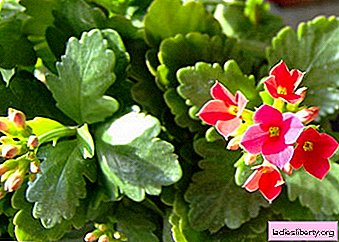
Kalanchoe belongs to the potylerkov family of indoor plants. In nature, the place of its growth is tropical and South Africa, South and Southeast Asia, and the tropics of South America. We grow this flower only in room conditions. Flower growers love it for its relative unpretentiousness and long flowering, which begins in the winter and lasts until July. The genus Kalanchoe unites about 200 species. The most popular of them are:
Kalanchoe Blossfeld - is a small shrub, growing to 45 cm. It has dark green, smooth leaves, slightly wavy at the edges. The decoration of the plant are numerous tubular flowers, gathered in inflorescences, umbrellas. Flowers in this species may be white, yellow, orange, pink, red. It is one of the most beautiful decorative flowering representatives of the Kalanchoe genus.
Kalanchoe Kalandiva - derived from Kalanchoe Blossfeld, but it has smaller sizes, shorter peduncles and a greater number of flowers, having the most diverse colors. Kalanchoe Kalandiva has a long flowering period, which can last up to six months.
Kalanchoe Mangina - distinguished by smaller leaves and flowers in the form of bells, reaching a length of about 2 cm.
Kalanchoe Degremona - refers to the decorative foliage of the flower. This plant has a straight stem with triangular leaves on it, reaching up to 10 cm in length. On the leaves are the daughter plants, which are small leaves with roots. These leaves fall away from the daughter leaf and root themselves in the ground.
Kalanchoe pinnate is one of the most hardy and viable species, growing up to 1 m in height. This plant has dense light green leaves and blooms with large greenish-white-pink flowers. Along the edge of the leaf, it also has daughter plants that subsequently take root in the ground. This type is used in the manufacture of Kalanchoe juice, which is a drug and is sold in pharmacies.
Kalanchoe - growing and care
Those who decided to grow this plant will not have to overcome special difficulties. First of all, this requires a cramped pot with poor soil with sand. The optimal mode for growing it will be a temperature of 15 ° C to 20 ° C. This flower loves heat, but its directional flows can harm the plant, so it should be kept away from the central heating battery or heaters.
This flower is very light-loving, so you need to provide him with bright lighting. This is necessary for more intense coloring of flowers and leaves. Some amount of direct sunlight is allowed, however, in the summer it should not be placed in the open sun to avoid burns.
During growth and flowering plants need to provide abundant watering and fertilizing with fertilizer once a week. It feels very good in conditions of high humidity. To maintain this mode, use a wet peat wrap on the pot.
Kalanchoe - replanting and reproduction
Repot the flower as needed (if it grows too much). The best time for a transplant is spring. However, it is necessary to produce it only after flowering, and only if the root system has filled the entire space of the pot. For transplanting you need to take a neutral or slightly acidic soil. To prepare the mixture for transplanting, take on one part of turf, leaf, peat land, one part of brick chips and one part of sand. You can add pieces of birch coal there, and instead of peat take coniferous soil. If there is no possibility to prepare such a mixture, it is best to buy a land mixture for succulent plants. The plant that is being transplanted must be pulled out of the ground by the root, trying not to damage the root system, and transfer it to a new pot that has a larger volume.
Kalanchoe seeds propagated by seeds and cuttings. Seeds should be sown in February-April in the ground for succulents, to which fine sand is added. Until seedlings appear, the containers are kept in an unlit place, maintaining a temperature of about 21 ° C. After sprouting, they are transplanted into a special cassette with soil mixture for succulents, and then into pots having a diameter of 6-8 cm. soil or soil mixture for succulents and sand. Until they take root, they are shaved and kept at about 22 ° C.
Kalanchoe - diseases and pests
Problems with the maintenance of plants, which lead to the loss of their decorative properties, occur, as a rule, from errors in care.
So, excessive watering, especially in winter, can lead to leaf rot. If this happens, they should be deleted.
Lack of light can also negatively affect the flower. This leads to stretching of the stems and dropping of the lower leaves, or loss of their color.
If after abundant flowering the plant does not grow or loses leaves, it means that it needs nourishment, therefore, it should be transplanted or start feeding.
Keeping in a very warm room can lead to the death of the leaves. In this case, it is necessary to optimize the maintenance conditions of the flower, providing it with a more suitable temperature regime.
If he looks healthy, he pleases you with large juicy green leaves, but does not bloom, it means that he was overfed with fertilizers.
Most often, this plant is affected by a shield, a spider mite and mealy worms. With a shield and a spider mite, they fight by spraying a plant with insecticide solutions; the mealybug is removed with a brush or a rag dipped in alcohol.
Thus, in order to grow this beautiful and useful flower, you only need a little patience and attention, in return for which you will receive a lot of positive emotions and an unforgettable atmosphere of beauty and comfort in your home.
Comments











